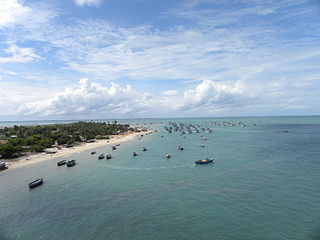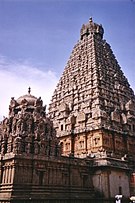Ramanathapuram, also known as Ramnad, is a city and a municipality in Ramanathapuram district in the Indian state of Tamil Nadu. It is the administrative headquarters of Ramanathapuram district and the second largest town in Ramanathapuram district.

Ramanathapuram District, also known as Ramnad District, is one of the 38 districts an administrative districts of Tamil Nadu state in southern India. The old Ramanathapuram District consists of Present day Virudhunagar and Sivagangai districts, it touches the Western ghats and bordered with the state of Kerala and east by Bay of Bengal. It was the largest district on that time. The town of Ramanathapuram is the district headquarters. Ramanthapuram District has an area of 4,123 km2. It is bounded on the north by Sivaganga District, on the northeast by Pudukkottai District, on the east by the Palk Strait, on the south by the Gulf of Mannar, on the west by Thoothukudi District, and on the northwest by Virudhunagar District. The district contains the Pamban Bridge, an east–west chain of low islands and shallow reefs that extend between India and the island nation of Sri Lanka, and separate the Palk Strait from the Gulf of Mannar. The Palk Strait is navigable only by shallow-draft vessels. As of 2011, Ramanathapuram district had a population of 1,353,445 with a sex-ratio of 983 females for every 1,000 males. The district is home to the pilgrimage centre of Rameswaram and tourist spot Dhanushkodi, an abandoned town.

Sivaganga District is one of the 38 districts in Tamil Nadu state, India. This district was formed on 15 March 1985 by trifurcation of Ramanathapuram district into Ramanathapuram, Virudhunagar and Sivaganga districts. Sivaganga is the district headquarters, while Karaikudi is the most populous city in the district, administered by the Karaikudi Municipal Corporation. It is bounded by Pudukkottai district on the Northeast, Tiruchirappalli district on the North, Ramanathapuram district on South East, Virudhunagar district on South West and Madurai district on the West. The area's other larger towns include Sivaganga, Kalayar Kovil, Devakottai, Manamadurai, Ilaiyangudi, Thiruppuvanam, Singampunari and Tiruppattur. As of 2011, the district had a population of 1,339,101 with a sex ratio of 1,003 females for every 1,000 males.

The Thanjavur Nayakdynasty were the rulers of Thanjavur in the 15th and 17th centuries. The Nayaks, who belonged to the Telugu-speaking Balija social group were originally appointed as provincial governors by the Vijayanagara Emperor in the 15th century, who divided the territory into Nayak kingdoms which were Madurai, Tanjore, Gingee and Kalahasthi. In the mid-15th century they became an independent kingdom, although they continued their alliance with the Vijayanagara Empire. The Thanjavur Nayaks were notable for their patronage of literature and the arts.
Pradani Muthirulappa Pillai, son of Sundra Pandya Pillai, of the 18th century was a Pradani of Ramnad during the reign of Muthuramalinga Sethupathy. As the king was a minor, just an infant, the Pradani took over the controls of a languishing kingdom and brought order and a sense of well-being by his careful planning and introduction of several tax and revenue reforms. Due to ideological differences that arose in later years between the king and himself, he was forced to retire from his position. The Ramnad Manual amply records his administrative prowess and tax reforms. Notable development during his administration as regent. Chokkatan mandapam of rameshwaram temple, one of Asia's largest corridors was constructed, he as a statesman planned meticulously, and organised committee to define route which merge both rivers and divert waters to drought hit part of southern Tamilnadu. It was based on his plan, mullai periyar dam was constructed by pennycuick after 100 years. He was gift to the kingdom of ramnad, his people know his worth due to his various measures of welfare of his people. He was practical person, only thing he preferred was his welfare of people. He saved the kingdom from drought. He is still remembered for his contribution by his people. He was very significant figure during his period, whose words are respected by all stakeholders.
The Madurai Nayaks were a Telugu dynasty who ruled most of modern-day Tamil Nadu, India, with Madurai as their capital. The Madurai Nayaks had their origins in the Balija warrior clans of present-day Andhra Pradesh. The Nayak reign which lasted for over two centuries from around 1529 to 1736 was noted for its achievements in arts, cultural and administrative reforms, revitalization of temples previously ransacked by the Delhi Sultans, and the inauguration of a unique architectural style.

The Thanjavur Maratha kingdom ruled by the Bhonsle dynasty was a principality of Tamil Nadu between the 17th and 19th centuries. Their native language was Thanjavur Marathi. Vyankoji Bhosale was the founder of the dynasty.
Sriman Hiranyagarbha Ravikula Raja Muthu Vijaya Raghunatha Raja Raghunatha Deva Kilavan Setupati was the first king of Ramnad Kingdom which is also known "Maravar Kingdom". He ruled from 1673 to 1708 and oversaw the growth of the feudal chieftainship of Ramnad into a powerful "Ramnad Kingdom" which is known as "Maravar Kingdom". He rescued the Nayak of Madurai from the tyranny of Rustam Khan and also successfully campaigned against the King of Thanjavur, who later ceded all his territories. It is recorded in the Sethupati copper plates that he belonged to the Surya kulam and Kashyap gothram.

The Thondaman or Thondaiman was a dynasty ruled the region in and around Pudukkottai from the 17th to 20th century. The Pudukkottai Thondaiman dynasty was founded by Raghunatha Thondaiman, the brother-in-law of the then Raja of Ramnad, RaghunathaKilavan Setupati. The Pudukottai Samasthanam was under Thondaiman dynasty for one year even after Indian Independence. The Thondaiman dynasty had a special Valari regiment.
The estate of Sivaganga, as per British records also known as Kingdom of the Lesser Marava, was a permanently settled zamindari estate in the Ramnad sub-division of Madura district, Madras Presidency, British India. Along the estate of Ramnad, it formed one of the two zamindari estates of Ramnad subdivision.
Shanmugha Rajeswara Sethupathi or Naganatha Sethupathi was an Indian politician of the Justice Party and later, the Indian National Congress and head of the zamindari of Ramnad or Ramnad kingdom from 1929 to 1967. He was a member of the Madras Legislative Assembly from 1951 to 1967 and served as a minister in C. Rajagopalachari and K. Kamaraj's cabinets. He was popular as the main political opponent of U. Muthuramalingam Thevar.
Ramaiyan, Ramayyan or Ramappaiyyan was a general who served under the Madurai Nayak king Tirumala Nayaka. He is the subject of the Tamil ballad Ramayyan Ammanai.

The Sethupathis are a Tamil clan of the Maravar community native to the Ramanathapuram and Sivaganga district of Tamil Nadu, India. They were from the 12th century considered independent kings in 16th century who ruled the Ramnad kingdom, also known as Maravar country. The male rulers of Ramnathapuram also bore the title of "Sethupathi" or "protector of the bridge", the bridge here referring to the legendary sacred Rama's Bridge, while female rulers bore the title "Nachiyar". Among the 72 poligars of the region, the Sethupathi stood first. This special position was conferred not based upon the revenue that his kingdom generated but because of his military prowess. Back in the beginning of the 18th century, the Sethupathi ruler could mobilize a considerable army, about 30,000 to 40,000 strong at short notice.

The Nayaks of Gingee (Senji) were Telugu rulers of the Gingee principality of Tamil Nadu between 16th to 18th century CE. The Gingee Nayaks had their origins in the Balija warrior clans of present-day Andhra Pradesh. They were subordinates of the imperial Vijayanagara emperors, and were appointed as provincial governors by the Vijayanagar Emperor who divided the Tamil country into three Nayakships viz., Madurai, Tanjore and Gingee. Later, after the fall of the Vijayanagara's Tuluva dynasty, the Gingee rulers declared independence. While they ruled independently, they were sometimes at war with the Tanjore neighbors and the Vijayanagara overlords later based in Vellore and Chandragiri. Gingee ruler Surappa nayaka had a brother called Era Krishnappa Nayak whose son established himself in Karnataka and his family came to be known afterwards as the Belur Nayakas.
Raja Sri Raghunatha Raya Tondaiman (1641–1730) was the ruler of the Pudukkottai kingdom from 1686 to 1730. A feudatory chieftain of the Sethupathi of Ramnad, in 1686, Raghunatha Raya Tondaiman was recognised as the independent ruler of Pudukkottai by the Sethupathi for the services he had rendered him.
The Marava war of succession was the war of succession between, Vijayaraghunatha Sethupathi, the heir apparent and eldest son of Raghunatha Kilavan, and Tanda Thevar for the throne of Ramnad kingdom, also known as the Maravar Kingdom. The war of succession and the ensuing civil war lasted from 1720 to 1729 and resulted in the partitioning of the Ramnad kingdom reducing its power and influence.

Vijayaraghunatha Sethupathi I ruled from 1713 to 1725 the "Ramnad Kingdom", also known as "Maravar Kingdom". He was an adopted son of Raghunatha Kilavan, the founder of the "Ramnad Kingdom". Sethupathi was the title granted by Thanjavur Nayaks to his adoptive father Raghunatha Kilavan, and this title was retained by his descendants.
Muthu Vaduganatha Periyavudaya Thevar was the second king of the Sivagangai Estate which is also known "Lesser Maravar Kingdom". He ruled from 1750 to 1772.












